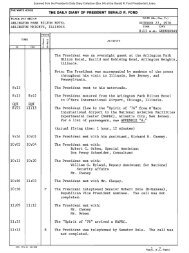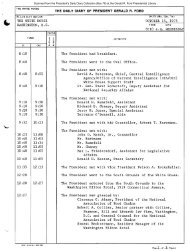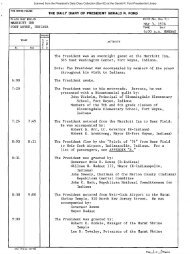October 31, 1975 - Gerald R. Ford Presidential Library and Museum
October 31, 1975 - Gerald R. Ford Presidential Library and Museum
October 31, 1975 - Gerald R. Ford Presidential Library and Museum
You also want an ePaper? Increase the reach of your titles
YUMPU automatically turns print PDFs into web optimized ePapers that Google loves.
The Bay March<strong>and</strong> Block 2 field is located just offshore from Lafourche<br />
Parish in southern Louisiana about 60 miles south of New Orleans in<br />
the offshore Miocene belt.<br />
There are more than 125 individual s<strong>and</strong> members at Bay March<strong>and</strong> in<br />
a thick s<strong>and</strong>-shale sequence of predominately Miocene age. They occur<br />
from 1,200 feet to 16,000 feet.<br />
The structure at Bay March<strong>and</strong> is related to a shallow piercement type<br />
salt dome which is one of the largest in the world (about nine miles<br />
in diameter at the 18,000 foot level). The field is highly faulted.<br />
The combination of faults <strong>and</strong> numerous s<strong>and</strong>s has caused more than 500<br />
individual stratigraphic or fault block reservoirs in the field. Some<br />
are superdomal at the crest; others are controlled by salt or shale<br />
truncation; <strong>and</strong> still others are s<strong>and</strong> pinchout situations. Faulting<br />
plays a major part in the delineation of the reservoirs. Most segments<br />
are underlain by bottom water. The field has about 13,900<br />
production acres (22 square miles).<br />
A volumetric analysis to determine hydrocarbons originally in place<br />
in each of the many individual reservoir segments was not practical.<br />
However such calculations were made for reservoirs which were being<br />
water flooded on the east, south, <strong>and</strong> west flanks of the field. Also,<br />
volumetric analyses were carried out for the nonas.sQciate.d gas:reservoirs<br />
at Bay March<strong>and</strong>.<br />
The primary producing mechanisms are combinations of dissolved gas<br />
drive, gas cap drive, <strong>and</strong> partial water drive. In addition, numerous<br />
segments are being water flooded. The consultant firm estimated<br />
ultimate recovery by the process of interpretation of production<br />
decline, well test, <strong>and</strong> water/Qil ratio! data in the reservoir segments<br />
not being water flooded. In the other reservoir segments (including<br />
nonassociated gas reservoirs), reserves were estimated by assigning<br />
recovery efficiency factors to estimates of hydrocarbons originally<br />
in place, <strong>and</strong> then by adjusting the predictive data to the various<br />
production decline curves. This appears to be a very reasonable<br />
<strong>and</strong> practical manner of h<strong>and</strong>ling a most tedious situation in the<br />
ti me span allotted. The overa 11 recovery effi ci enci es came down to<br />
46 percent of oil <strong>and</strong> 71 percent of gas originally in place.<br />
The FEA report on the Bay March<strong>and</strong> Block 2 Field was prepared by<br />
Keplinger <strong>and</strong> Associates, Inc., under Contract No. CO-05-50l84-00.<br />
18
















